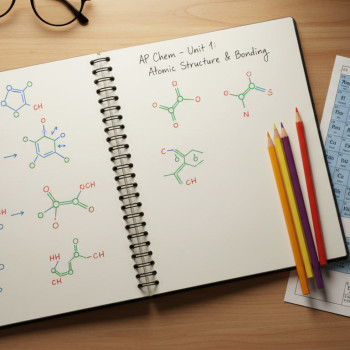Physics 1 Energy & Power: Conservation Scripts
Welcome to a friendly, practical guide to one of the most elegant and exam-ready parts of AP Physics 1: energy and power. If you’ve ever wished physics came with a stage script — a clear, repeatable sequence you can rely on under test pressure — this blog delivers exactly that. We’ll build conservation “scripts” you can run in your head when you see a problem, groove through examples that mimic AP-style questions, and layer in study tactics to help knowledge stick.

Why conservation scripts work
Conservation laws are the shortcuts of physics. Instead of tracking every force and acceleration, you follow invariants — things that don’t change — and that usually wins you points quickly and cleanly on the AP exam. The word “script” is helpful because it frames your thought process as a checklist: each step reduces ambiguity, clarifies assumptions, and helps you avoid careless mistakes.
When we speak of energy and power in AP Physics 1, we usually mean mechanical energy (kinetic and gravitational potential, sometimes elastic potential), work done by non-conservative forces (like friction), and instantaneous/average power. These concepts form a compact toolkit: conservation of mechanical energy, energy accounting with work, and power as energy per time.
Core equations to memorize (and what they mean)
- KE = 1/2 mv^2 — kinetic energy, energy of motion.
- U_g = mgh — gravitational potential for near-Earth problems (use the same zero as the question uses!).
- U_spring = 1/2 kx^2 — elastic potential energy (if springs appear).
- W = F dot d = Fd cosθ — work done by a constant force along displacement.
- ΔE_mech = W_nc — change in mechanical energy equals work done by nonconservative forces (friction, applied forces, etc.).
- P_avg = W/Δt and P_inst = F · v — average and instantaneous power.
Conservation Script 1 — The Energy-Only Route (when mechanical energy is conserved)
Use this when the problem states or implies no friction, no air resistance, and no energy losses. Example cues: “frictionless surface,” “neglect air resistance,” “smooth.”
Step-by-step script
- Step 1 — Identify the system (ball, block+spring, roller coaster car, etc.).
- Step 2 — Choose reference points and define gravitational potential zero (pick what simplifies the algebra).
- Step 3 — Write initial mechanical energy: E_i = KE_i + PE_i.
- Step 4 — Write final mechanical energy: E_f = KE_f + PE_f.
- Step 5 — Set E_i = E_f and solve for the unknown (speed, height, compression, etc.).
- Step 6 — Check units and reasonableness (speed nonnegative, energy decreases if you expect losses, etc.).
Worked example (AP-style)
Problem: A 2.0 kg block slides from rest from the top of a 4.0 m high frictionless ramp. What is its speed at the bottom?
Script run-through:
- System: block. Choose U_g = 0 at bottom.
- E_i = mgh = (2.0)(9.8)(4.0) = 78.4 J. KE_i = 0.
- E_f = 1/2 mv^2 + 0. Set 78.4 = 1/2 (2.0) v^2 → 78.4 = v^2.
- v = sqrt(78.4) ≈ 8.86 m/s. Check: units m/s, positive — done.
Conservation Script 2 — Energy Accounting with Nonconservative Work
When friction, applied forces, or other nonconservative effects appear, mechanical energy is not conserved. Instead, use the work-energy relation: ΔE_mech = W_nc. This is also the route to calculate power when a force does work over time.
Step-by-step script
- Step 1 — Identify all energy stores initially and finally (KE, U_g, U_s).
- Step 2 — List nonconservative forces doing work (friction, applied force, normal force if it moves, etc.).
- Step 3 — Compute W_nc (often W_friction = -f_k d or W_applied = Fd cosθ).
- Step 4 — Use ΔE_mech = E_f − E_i = W_nc. Solve for unknown.
- Step 5 — Interpret sign: negative W_nc means loss of mechanical energy (converted to thermal or other forms).
Worked example (AP-style)
Problem: A 5 kg box is pulled 8 m along a horizontal floor at constant speed by a force of 30 N directed 20° above the horizontal. The coefficient of kinetic friction is 0.25. How much work is done by friction? How much power does the pulling force supply if the motion takes 4.0 s?
Script run-through (friction work):
- Normal force: N = mg − F_y = mg − F sin20°. Compute N ≈ 5*9.8 − 30*sin20° ≈ 49 − 10.27 ≈ 38.73 N.
- Friction force f_k = μ_k N ≈ 0.25 * 38.73 ≈ 9.68 N, opposing motion.
- Work by friction W_f = −f_k d = −(9.68)(8) ≈ −77.44 J.
- Power by pulling force: W_pull = F d cosθ = 30*8*cos20° ≈ 30*8*0.94 ≈ 225.6 J total. P_avg = 225.6 / 4.0 ≈ 56.4 W.
Notes: The net work is zero here because constant speed implies ΔKE = 0, so W_pull + W_f + W_normal_y + W_gravity = 0; W_normal_y and W_gravity cancel in displacement purely horizontal.
Conservation Script 3 — Mixed Systems: Springs and Heights
Problems that combine springs, heights, and motion are common on AP exams. Treat elastic potential just like gravitational potential in your scripts.
Step-by-step script
- Step 1 — Write E_i including 1/2 k x_i^2 if spring is compressed/stretched.
- Step 2 — Write E_f including 1/2 k x_f^2.
- Step 3 — Include any W_nc if friction or damping exists.
- Step 4 — Solve algebraically, keep track of sign conventions for x (compression vs. extension).
Worked example (AP-style)
Problem: A block of mass 0.5 kg is released from rest when a spring (k = 200 N/m) compressed by 0.10 m is at x = 0 (spring relaxed is x = +0.10 m). If the block moves across a frictionless surface and leaves the spring at the equilibrium point, what is its speed?
Script run-through:
- E_i = 1/2 k x^2 = 1/2 * 200 * (0.10)^2 = 1.0 J.
- E_f = 1/2 mv^2 at the moment it leaves spring (spring uncompressed, PE_spring = 0).
- 1.0 = 1/2 * 0.5 * v^2 → 1.0 = 0.25 v^2 → v^2 = 4 → v = 2.0 m/s.
Power: Quick Scripts to Avoid Messy Algebra
Power questions often ask for average or instantaneous power, sometimes in the context of doing work over time or maintaining a constant speed against friction. Keep these short scripts handy.
Script for average power
- Step 1 — Find total work done by the force over time interval Δt (W = F d cosθ or energy change ΔE).
- Step 2 — P_avg = W / Δt.
Script for instantaneous power
- Step 1 — If given force and instantaneous velocity, use P_inst = F · v (dot product). If angle θ between F and v, P_inst = F v cosθ.
- Step 2 — Units: watts (J/s). Check sign: negative means force is removing energy from system.
Common exam traps and how your script defuses them
- Trap: Forgetting to include both KE and PE at each state. Script fix: always write E_i and E_f explicitly before canceling terms.
- Trap: Misplacing the zero of gravitational potential. Script fix: pick U = 0 smartly; state it on your diagram.
- Trap: Using conservation when friction is present. Script fix: look for words like “friction” or “nonconservative”; if present, switch to ΔE = W_nc.
- Trap: Sign errors for work (especially friction). Script fix: draw the force direction and displacement vector; W = F d cosθ — sign pops out naturally.
- Trap: Mixing average and instantaneous power. Script fix: note if a time interval is given (average) vs. a moment with a velocity (instantaneous).
Visual cheat-sheet: Quick reference table
| Concept | Equation | When to Use |
|---|---|---|
| Kinetic Energy | KE = 1/2 mv^2 | Any moving mass; compare speeds |
| Gravitational Potential | U_g = mgh | Heights near Earth’s surface |
| Spring Potential | U_s = 1/2 kx^2 | Compressed or stretched springs |
| Work | W = F d cosθ | Force acting over displacement |
| Energy Accounting | ΔE_mech = W_nc | Nonconservative forces present |
| Power | P_avg = W/Δt, P_inst = F · v | Energy per time |
How to translate AP Free Response prompts into scripts
FRQs on AP Physics 1 often include words like “describe,” “show,” and “calculate.” Translating the language into your conservation script keeps your answer organized and scores higher on the rubric.
Translation tips
- “Show that” — run the algebra cleanly and state your assumptions (e.g., neglect friction, choose U = 0).
- “Explain” — use short sentences linking physical cause and effect: “Friction does negative work, so mechanical energy decreases and kinetic energy is reduced by X J.”
- “Calculate” — give numeric answer with units and one-line justification from your script steps.
Practice strategy: how to study these scripts efficiently
Mastery comes from deliberate repetition. Here’s a study loop you can follow every week leading to the AP exam.
- Cycle A — Concept review: 20–30 minutes. Read and summarize the conservation scripts in your own words.
- Cycle B — Guided problems: 3–4 AP-style problems. Time yourself and practice writing the script at the top of each solution.
- Cycle C — Mixed set: 10-minute mixed quiz with energy/power problems and immediate feedback.
- Cycle D — Reflection: Identify the three mistakes you made and explicitly correct them in a short note.
Using this loop weekly builds procedural fluency and reduces anxiety under timed conditions. Consider keeping one “script card” per conservation script and glance at it before practice sets.

How tutoring (and smart tools) can speed your progress
When you’re close to mastery, personalized feedback makes the difference between a good score and an excellent one. Sparkl’s personalized tutoring offers 1-on-1 guidance, tailored study plans, and expert tutors who can debug your script in real time. Tutors can spot habitual mistakes — like picking inconsistent reference heights or sign errors — and give targeted drills. AI-driven insights can also surface which energy topics you repeatedly miss, letting you focus study time more efficiently.
For example, if you consistently mishandle friction, a tailored plan can give you more problems where W_nc plays a central role, plus quick mnemonic techniques to remember sign conventions. The combination of human tutoring and AI-driven practice provides both immediate correction and long-term learning analytics — the kind of feedback loop that helps you internalize the conservation scripts so they become second nature under test pressure.
Exam-day checklist: run your conservation script in 90 seconds
Before you grab a problem, take a quick mental inventory. This 90-second ritual helps orient your thoughts and reduces silly errors.
- Read the full problem once for context — note masses, heights, springs, and time intervals.
- Circle words like “frictionless,” “constant speed,” or “applied force.”
- Draw a quick diagram with velocity arrows, forces, and a chosen U = 0 line.
- Write which script you’ll run at the top: “Energy-Only” or “Energy + W_nc” or “Power.”
- Proceed with algebra; put units in final line and sanity-check the magnitude.
Sample timed mini practice (20 minutes)
Try this during a practice session. Time yourself for 20 minutes and use the scripts exactly as written.
- Problem 1 (8 minutes): A 1.5 kg block slides down a 3.0 m frictionless incline from rest. Find its speed at the bottom.
- Problem 2 (8 minutes): A 2.0 kg box is dragged 6.0 m at constant speed by a horizontal force of 12 N. The coefficient of kinetic friction is 0.20. Compute the work done by friction and the power if the motion takes 3.0 s.
- Reflection (4 minutes): Check answers, identify one mistake, and write a 2-sentence correction plan.
Final tips to make conservation scripts stick
- Explain problems aloud — teaching is an instant stress test for clarity.
- Use small whiteboards for sketching energy bars and writing E_i and E_f — visual memory is powerful.
- Practice a variety of contexts: ramps, springs, pulleys, collisions (where you combine momentum and energy concepts cautiously), and rotating objects if included.
- Don’t skip unit checks — they catch many algebra mistakes quickly.
- Work in short, focused sessions with deliberate feedback; if possible, use a tutor for targeted weak points. Sparkl’s tutors are good at breaking down persistent errors into fixable micro-skills and building a tailored practice plan that fits your schedule.
Wrap-up: your pocket script for last-minute review
Here’s a tiny, memorized script you can run in your head during the exam:
- Circle nonconservative words. If none, use Energy-Only; if present, use Energy + W_nc.
- Choose U = 0 to simplify algebra and state it on the diagram.
- Write E_i = KE_i + PE_i and E_f = KE_f + PE_f.
- Set E_i − E_f = −W_nc (or E_i = E_f if conservative), solve, and check units.
- Quick sanity check: sign, magnitude, units.
Run this script once before you answer. It takes seconds and dramatically reduces the rough edges in your solutions.
Parting encouragement
Energy and power problems reward clean thinking more than flashy algebra. If you practice the scripts above until they become almost automatic, you’ll save precious time on the AP Physics 1 exam and turn confusing situations into routine calculations. Remember: the goal is not just to get the right number, but to show a clear, physical chain of reasoning. That’s what graders look for, and that’s also what real understanding looks like.
If you want a customized plan or a quick review session before test day, consider pairing these scripts with a few 1-on-1 Sparkl tutoring sessions — focused feedback accelerates improvement and helps you turn weak spots into strengths.
Good luck — practice deliberately, keep the scripts handy, and trust the process. You’ve got this.




















No Comments
Leave a comment Cancel